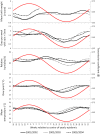Using mathematical transmission modelling to investigate drivers of respiratory syncytial virus seasonality in children in the Philippines
- PMID: 24587222
- PMCID: PMC3937436
- DOI: 10.1371/journal.pone.0090094
Using mathematical transmission modelling to investigate drivers of respiratory syncytial virus seasonality in children in the Philippines
Abstract
We used a mathematical transmission model to estimate when ecological drivers of respiratory syncytial virus (RSV) transmissibility would need to act in order to produce the observed seasonality of RSV in the Philippines. We estimated that a seasonal peak in transmissibility would need to occur approximately 51 days prior to the observed peak in RSV cases (range 49 to 67 days). We then compared this estimated seasonal pattern of transmissibility to the seasonal patterns of possible ecological drivers of transmissibility: rainfall, humidity and temperature patterns, nutritional status, and school holidays. The timing of the seasonal patterns of nutritional status and rainfall were both consistent with the estimated seasonal pattern of transmissibility and these are both plausible drivers of the seasonality of RSV in this setting.
Conflict of interest statement
Figures




Similar articles
-
Exploring the dynamics of respiratory syncytial virus (RSV) transmission in children.Theor Popul Biol. 2016 Aug;110:78-85. doi: 10.1016/j.tpb.2016.04.003. Epub 2016 May 4. Theor Popul Biol. 2016. PMID: 27155294
-
Environmental drivers of the spatiotemporal dynamics of respiratory syncytial virus in the United States.PLoS Pathog. 2015 Jan 8;11(1):e1004591. doi: 10.1371/journal.ppat.1004591. eCollection 2015 Jan. PLoS Pathog. 2015. PMID: 25569275 Free PMC article.
-
Respiratory syncytial virus seasonality, transmission zones, and implications for seasonal prevention strategy in China: a systematic analysis.Lancet Glob Health. 2024 Jun;12(6):e1005-e1016. doi: 10.1016/S2214-109X(24)00090-1. Epub 2024 Apr 23. Lancet Glob Health. 2024. PMID: 38670132
-
The importance of the local environment in the transmission of respiratory syncytial virus.Sci Total Environ. 2014 Sep 15;493:521-5. doi: 10.1016/j.scitotenv.2014.06.021. Epub 2014 Jun 26. Sci Total Environ. 2014. PMID: 24973721
-
Respiratory syncytial virus epidemics: the ups and downs of a seasonal virus.Pediatr Infect Dis J. 2003 Feb;22(2 Suppl):S21-32. doi: 10.1097/01.inf.0000053882.70365.c9. Pediatr Infect Dis J. 2003. PMID: 12671449 Review.
Cited by
-
Use of mathematical modelling to assess respiratory syncytial virus epidemiology and interventions: a literature review.J Math Biol. 2022 Feb 26;84(4):26. doi: 10.1007/s00285-021-01706-y. J Math Biol. 2022. PMID: 35218424 Free PMC article. Review.
-
Modelling respiratory syncytial virus age-specific risk of hospitalisation in term and preterm infants.BMC Infect Dis. 2024 May 21;24(1):510. doi: 10.1186/s12879-024-09400-2. BMC Infect Dis. 2024. PMID: 38773455 Free PMC article.
-
Meteorological factors and respiratory syncytial virus seasonality in subtropical Australia.Epidemiol Infect. 2018 Apr;146(6):757-762. doi: 10.1017/S0950268818000614. Epub 2018 Mar 21. Epidemiol Infect. 2018. PMID: 29560833 Free PMC article.
-
Impact of routine prophylaxis with monoclonal antibodies and maternal immunisation to prevent respiratory syncytial virus hospitalisations, Lombardy region, Italy, 2024/25 season.Euro Surveill. 2025 Apr;30(14):2400637. doi: 10.2807/1560-7917.ES.2025.30.14.2400637. Euro Surveill. 2025. PMID: 40211969 Free PMC article.
-
Factors associated with severe respiratory syncytial virus infection among hospitalized children in Thammasat University Hospital.F1000Res. 2024 May 17;13:231. doi: 10.12688/f1000research.146540.2. eCollection 2024. F1000Res. 2024. PMID: 39055881 Free PMC article.
References
-
- Weber MW, Mulholland EK, Greenwood BM (1998) Respiratory syncytial virus infection in tropical and developing countries. Tropical Medicine & International Health 3: 268–280. - PubMed
-
- Shek LP-C, Lee B-W (2003) Epidemiology and seasonality of respiratory tract virus infections in the tropics. Paediatric Respiratory Reviews 4: 105–111. - PubMed
Publication types
MeSH terms
LinkOut - more resources
Full Text Sources
Other Literature Sources
Medical

